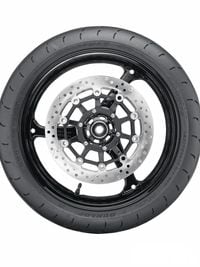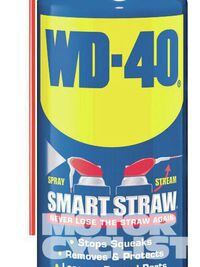Got a question for Answers?
Send it to mcmail@bonniercorp.com
Under Pressure
I work in a small shop. Our parts counterperson, who races, has me change tires and then asks what pressure I set them at. After explaining I set them at whatever pressure the bike manufacturer recommends, he tells me the front tire should have more pressure than the rear. If the manufacturer says 32 psi in the front and 36 psi in the rear, he says that should be reversed, telling the customer more pressure in the front is correct because that's what he uses in a race. I'd never heard of doing that on the street, and it's crazy to send a customer out on new tires with a "race setup." I tried to explain that street tires and DOT race tires are different animals, but I don't race, so I know nothing. Can you guys shed a little light on this subject?
Mike Hill
Battle Ground, WA
After talking to Mike Manning at Dunlop, you know more than your parts guy thinks you do. “Correct air pressure is a critical part of motorcycle tire design, and how that tire actually works,” Manning says. “A tire flexes more when it’s underinflated. Picture the tire and wheel as they turn. Centrifugal force is trying to fling the tire off the wheel. Then the tire touches pavement and pushes back. This continual flexing generates heat inside the tire, which eventually wears out the tire. Best-case scenario: You get a lot less mileage out of an underinflated tire than you would a properly inflated one. Worst case: An underinflated tire breaks down and fails while you’re riding.
“We have pneumatic tires instead of solid rubber ones so the tire can flex a little, acting as part of the bike’s suspension system, especially when it’s leaned over, improving grip and feel. An underinflated tire flexes way too much, and its performance suffers.
_ “Different tires serve different purposes, and some race tires require different pressures at a given track. A street tire spends more of its life straight up-and-down than leaned over, so running anything less than the motorcycle manufacturer’s recommended pressure just beats the heck out of it and puts the rider at risk.”_
Fish Story
I've used WD-40 for everything from drive chains to guitar strings to removing lipstick stains (don't ask). Now my best riding buddy swears it's mostly fish oil? Is that truth or urban myth?
Sam Duncan
Providence, RI
Myth: WD-40—short for Water Displacement, 40th Attempt—was originally developed at the Rocket Chemical Company in 1953 to prevent oxidation on Atlas nuclear missiles. Though there’s no list of ingredients on the can because its exact constituents are a closely guarded secret, the "Spray of 2000 Uses" is petroleum-based: a mineral-oil cocktail comprised of designer molecules such as Cyclohexane and Dimethylnaphthalene, not Cod livers.
Burn The Bra
I recently purchased a 1998 Honda CBR600F3. This is my first streetbike, and although it's 13 years old, it's in beautiful shape. My question is about the black-leather tank bra that was on the bike when I bought it. I think it looks better than the red paint, but are tank bras so out-of-date that I'll be embarrassed riding around with it on my bike? I do not see many leather tank bras anymore.
Dustin Wirsing
Milwaukee, WI
Embarrassed? No. Mortified? Yes. Lose the leather brassiere or face a ticket from the Fashion Police. You may have thick skin, but dirt embedded in that crusty old bra will give your paint a nasty rash if it hasn’t already. If the finish is still worth protecting, install some 3M Scotchguard paint-protection film and you’ll have an invisible, removable layer of urethane protection.
No Pair
Would removing the PAIR clean-air valves and installing aftermarket block-off plates make my 2005 Kawasaki ZX-10R easier to tune on the dyno? How about removing the airbox cover? Are these typical modifications? Would I see any great benefit? Dealers just tell me to see for myself.
Ben Moore
Snohomish, WA
Steve Syx at Brock’s Performance says deleting the PAIR system will silence that popping you hear under deceleration with a stock exhaust. Aside from shaving a bit of weight, you won’t reap any other discernable benefits. Typical? Maybe. Productive? Not so much. An open airbox negates the Kawasaki’s ram-air effect for starters, so leave the lid on.
FAQ?
I'm almost afraid to ask because all my friends think any third-grader already knows the answer, but what is a slipper clutch? I thought my clutch wasn't supposed to slip?
When your engine is driving your rear wheel, your clutch isn’t slipping. When your rear wheel tries to drive your engine faster than it’s willing to turn after a few downshifts, a slipper clutch slips—typically via a series of spring-loaded ramps—to keep that rear wheel turning. In addition to preventing the dreaded lockup, fractional disengagement also prevents embarrassing/expensive over-revving and helps your rear suspension do its job.















/cloudfront-us-east-1.images.arcpublishing.com/octane/ITNLTIU5QZARHO733XP4EBTNVE.jpg)
/cloudfront-us-east-1.images.arcpublishing.com/octane/VZZXJQ6U3FESFPZCBVXKFSUG4A.jpg)
/cloudfront-us-east-1.images.arcpublishing.com/octane/QCZEPHQAMRHZPLHTDJBIJVWL3M.jpg)
/cloudfront-us-east-1.images.arcpublishing.com/octane/HXOUJXQWA5HBHGRO3EMJIGFMVI.jpg)

/cloudfront-us-east-1.images.arcpublishing.com/octane/3TIWWRV4JBBOLDVGRYECVVTA7Y.jpg)
/cloudfront-us-east-1.images.arcpublishing.com/octane/KIX5O23D5NAIBGFXBN3327DKZU.jpg)
/cloudfront-us-east-1.images.arcpublishing.com/octane/7GJYDUIPXRGMTMQKN6ONYOLBOU.jpg)
/cloudfront-us-east-1.images.arcpublishing.com/octane/MUQLOVLL2ZDGFH25ILABNBXKTI.jpg)
/cloudfront-us-east-1.images.arcpublishing.com/octane/TNOU5DNE2BC57MFPMGN2EIDXAM.jpg)
/cloudfront-us-east-1.images.arcpublishing.com/octane/GTCXACQGJ5HAPDTGWUQKDEH44E.jpg)
/cloudfront-us-east-1.images.arcpublishing.com/octane/S35YGSEMEZB4BLTDJTSZPF4GLA.jpg)
/cloudfront-us-east-1.images.arcpublishing.com/octane/5UOT6HPX2JFMRJAX6EH45AR4MQ.jpg)
/cloudfront-us-east-1.images.arcpublishing.com/octane/OKWOJWAKP5EP3OACCRRWPCIX2Q.jpg)
/cloudfront-us-east-1.images.arcpublishing.com/octane/2WF3SCE3NFBQXLDNJM7KMXA45E.jpg)
/cloudfront-us-east-1.images.arcpublishing.com/octane/G4MG6OUCJNBSHIS2MVVOTPX65E.jpg)
/cloudfront-us-east-1.images.arcpublishing.com/octane/IIGGWFOTOJGB7DB6DGBXCCMTDY.jpg)
/cloudfront-us-east-1.images.arcpublishing.com/octane/QSTCM6AVEZA5JJBUXNIQ3DSOF4.jpg)
/cloudfront-us-east-1.images.arcpublishing.com/octane/U4I7G625B5DMLF2DVIJDFZVV6M.jpg)
/cloudfront-us-east-1.images.arcpublishing.com/octane/B6XD6LS6IVCQPIU6HXDJSM3FHY.jpg)
/cloudfront-us-east-1.images.arcpublishing.com/octane/ICL63FEDDRDTTMINYICCEYGMDA.jpg)
/cloudfront-us-east-1.images.arcpublishing.com/octane/FCGZHQXRBZFLBAPC5SDIQLVF4I.jpg)
/cloudfront-us-east-1.images.arcpublishing.com/octane/WNOB6LDOIFFHJKPSVIWDYUGOPM.jpg)
